While there are now scores of cases from the Boards of Appeal, as well as several judgments from the General Court and the ECJ, which provide further guidance as to how position marks should be treated, important questions remain unanswered. This article summarises repeatedly applied tests used to assess the validity of position marks, discusses the applicability to position marks of the absolute grounds for refusal for shape marks set out in Articles 7(1)(e) (i) to (iii) of the EU Community Trademark Regulation and takes a brief look into the future.
No specific category of mark
Article 4 of the regulation states: “A Community trade mark may consist of any signs capable of being represented graphically, particularly words, including personal names, designs, letters, numerals, the shape of goods or of their packaging, provided that such signs are capable of distinguishing the goods or services of one undertaking from those of other undertakings.”
Neither the regulation nor its implementing regulation (Commission Regulation (EC) 2686/95) refers to position marks as a specific category of mark. However, the General Court has argued in various judgments that, insofar as Article 4 does not contain an exhaustive list of signs capable of being Community trademarks, that has no bearing on the registrability of position marks.
Position marks have been explicitly acknowledged in the OHIM Guidelines, Paragraph 2.2.14 of which states: “Applications for position marks effectively seek to protect a sign which consists of elements (figurative, colour, etc.) positioned on a particular part of a product and being in a particular proportion to the size of the product. The representation of the mark supplied must be accompanied by a description indicating the exact nature of the right concerned.”
According to the OHIM Guidelines, the factors to be taken into account when examining 3D marks are also relevant for position marks. It is stated that “in particular, the examiner must consider whether the relevant consumer will be able to identify a sign which is independent from the normal appearance of the products themselves”. The examiner should also consider whether the positioning of the mark upon the goods is likely to be understood “as having a trademark context”. The examiner should take into account that “in certain contexts, given the norms and customs of particular trades, a position mark may appeal to the eye as an independent feature being distinguishable from the product itself and thus communicating a trade mark message”.
Assessing validity – distinctive character
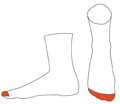 When looking at the case law from the ECJ and the General Court, position marks are generally found to be similar to the categories of both figurative and 3D marks, since they concern figurative or 3D elements that are applied to the surface of a product. However, it is argued that the classification of a positional mark as a figurative or 3D mark is irrelevant for the purpose of assessing its distinctive character (see, among others, X Technology v OHIM, General Court Case T‑547/08, June 15 2010 (orange on toe of sock [IEF 8912])).
When looking at the case law from the ECJ and the General Court, position marks are generally found to be similar to the categories of both figurative and 3D marks, since they concern figurative or 3D elements that are applied to the surface of a product. However, it is argued that the classification of a positional mark as a figurative or 3D mark is irrelevant for the purpose of assessing its distinctive character (see, among others, X Technology v OHIM, General Court Case T‑547/08, June 15 2010 (orange on toe of sock [IEF 8912])).
In accordance with established EU case law, the distinctive character of a sign is assessed by reference to the goods or services in respect of which registration is sought and the perception that the relevant public has of those goods and services. As a general factual starting point included in many other ECJ decisions relating to shape-of-products marks, it is argued that the more closely the shape or other elements of the mark for which registration is sought resemble those elements most likely to be taken by the product in question, the greater the likelihood of the shape being devoid of any distinctive character for the purposes of Article 7(1)(b) of the Community Trademark Regulation. As a result, it is argued in various position mark decisions that, to the extent to which average consumers are not in the habit of making assumptions as to the commercial origin of goods on the basis of signs which are indistinguishable from the appearance of the goods themselves, such signs will be inherently distinctive only if they depart significantly from the norm or customs of the sector.
In this regard, the mere fact that a shape or appearance is a variant of a common shape of the type of product at hand is not sufficient to establish that the mark is not devoid of distinctive character. A simple departure is not enough; the departure must be significant (Henkel v OHIM, ECJ Case C-218/01, February 12 2004). Moreover, the novelty or originality of the shape is also irrelevant (Think Schuwerk GmbH v OHIM, Case T-208/12, General Court, July 11 2013).
(In)distinguishable from appearance? A matter of fact
The decisive factor governing the applicability of this test is not the classification of the sign as a figurative, 3D or other mark, but the fact that it is indistinguishable from the appearance of the product in question. This criterion has been applied before in ECJ case law – not only to 3D marks, but also to figurative marks consisting of a two-dimensional (2D) representation of the product in question and also to a sign consisting of a design applied to the surface of the product.
Likewise, colours and abstract combinations are not regarded by the ECJ as intrinsically distinctive, save in exceptional circumstances, since they are indistinguishable from the appearance of the goods designated and are not, in principle, used to identify commercial origin. In those circumstances, it is necessary to determine whether the mark applied for is indistinguishable from the appearance of the designated product or whether, on the contrary, it departs significantly from the norm and customs of the relevant sector.
In K-Swiss Inc v OHIM (General Court, Case T-85/13, June 13 2014, [IEF 13937]) the General Court considered that, in addition to the above-mentioned criterion, the sign at issue must be independent of the appearance of the product that it designates in order, in particular, not to be perceived by the relevant public as merely a decorative element. While referring to Glaverbel v OHIM (Case T‑36/01, October 9 2002 (surface of a plate of glass)), the General Court considered that in order to be afforded distinctive character, a design applied to the surface of a product must be capable of being apprehended without the product’s inherent qualities being perceived simultaneously, so that the design can be easily and instantly recalled by the relevant public as a distinctive sign.
 Figure 1: The General Court found that K-Swiss had not proven that the five parallel stripe could be apprehended without the intrinsic characteristics of those shoes being simultaneously perceived
Figure 1: The General Court found that K-Swiss had not proven that the five parallel stripe could be apprehended without the intrinsic characteristics of those shoes being simultaneously perceived
With regard to the application depicted in Figure 1, the General Court found that the applicant, K-Swiss, had not proven that the five parallel stripes, applied to the external surface of business or dress shoes, could be apprehended without the intrinsic characteristics of those shoes being simultaneously perceived. K-Swiss therefore failed to prove that those five stripes could be easily and instantly recalled by the relevant public as a distinctive sign.
Applicants have been keen to argue that their marks are distinguishable from the mere shape of the product in question or indeed mere decoration. While the ECJ has left it open that marks which go to the shape or decoration of a product could have inherent distinctiveness, aside from cases where acquired distinctiveness has been successfully established, this will rarely be the case.
The ECJ has been keen to point out in several cases that such limitations are not absolute rules of law, but rather matters of fact about the nature of consumers.
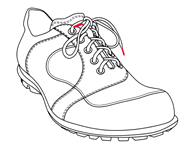 A good example of this important distinction is Think Schuhwerk GmbH v OHIM (ECJ, Case C-521/13 P, September 11 2014) which concerned red aglets on shoelaces. The General Court had found that the aglets were indissociable from the shoes and, as such, the mark was indistinguishable from the appearance of the product. Being indistinguishable, unless acquired distinctiveness could be established, it would be very difficult for the aglets to have any distinctiveness at all. The ECJ would not accept a plea that the assessment of indissociability was wrong, as this was a matter of fact not law. Think Schuhwerk could not make out its appeal and the mark was rejected.
A good example of this important distinction is Think Schuhwerk GmbH v OHIM (ECJ, Case C-521/13 P, September 11 2014) which concerned red aglets on shoelaces. The General Court had found that the aglets were indissociable from the shoes and, as such, the mark was indistinguishable from the appearance of the product. Being indistinguishable, unless acquired distinctiveness could be established, it would be very difficult for the aglets to have any distinctiveness at all. The ECJ would not accept a plea that the assessment of indissociability was wrong, as this was a matter of fact not law. Think Schuhwerk could not make out its appeal and the mark was rejected.
Applicants should be extremely vigilant as to this distinction between facts and law: not only should it change the approach to the kind of evidence submitted to a fact-finding tribunal, but care should also be taken that any appeals on matters of law are actually matters of law.
Functional and decorative elements
In Rosenruist – Gestão e serviços Lda v OHIM (General Court, Case T-388/09, September 28 2010) the General Court found that whether a (position) mark may serve a decorative or ornamental purpose is irrelevant for the purposes of assessing its distinctive character.
At the same time, the court considered that it is always necessary for the sign in question – even if it may serve a decorative purpose and need not meet a specific level of creativity – to have a minimum degree of distinctive character. In this case, the application was rejected, the General Court considering it to be a simple, commonplace pattern with an exclusively decorative function, no aspect of which would enable the relevant public to identify the commercial origin of the goods described in the application or to distinguish them from others.
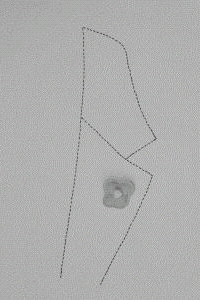 Another example of a sign found to be decorative is Landini Srl v OHIM (General Court, Case T-131/13, March 14 2014 [IEF 13644 F)]), concerning the application for a flower on a collar.
Another example of a sign found to be decorative is Landini Srl v OHIM (General Court, Case T-131/13, March 14 2014 [IEF 13644 F)]), concerning the application for a flower on a collar.
The General Court found that it is well known that a flower can adorn a buttonhole positioned on the collar of an item of clothing. According to the court, this circumstance weakened the capacity of the mark at issue to serve as an indication of the commercial origin of the products in question. The mark was rejected.
 In its decision of January 16 2014 the General Court considered the famous ‘button in the ear’ motif of Steiff teddy bears (Margarete Steiff GmbH v OHIM, General Court, Case T-434/12, January 16 2014 [IEF 13433]). This mark was registered in Germany and, to those familiar with Steiff bears, it came as a surprise when the application was rejected by the General Court. The court determined that “[the marks] would rather be perceived by the relevant public as a possible presentation of immovable labels which can be found on many different places of stuffed animals or as an original form of ornamentation.
In its decision of January 16 2014 the General Court considered the famous ‘button in the ear’ motif of Steiff teddy bears (Margarete Steiff GmbH v OHIM, General Court, Case T-434/12, January 16 2014 [IEF 13433]). This mark was registered in Germany and, to those familiar with Steiff bears, it came as a surprise when the application was rejected by the General Court. The court determined that “[the marks] would rather be perceived by the relevant public as a possible presentation of immovable labels which can be found on many different places of stuffed animals or as an original form of ornamentation.
They will thus not be perceived by the relevant public as an indication of the commercial origin of the products”. The court continued that the fixing of the button to the ear “in fact created a banal combination, which will be seen by the public as a decorative element, even functional”.
 The concept of functionality – and the likelihood that a functional feature will not be inherently distinctive – was also discussed in Lange Uhren GmbH v OHIM (General Court, Case T-152/07, September 14 2009 [IEF 8195]). In that case, the mark claimed was for circles and ellipses on a watch face.
The concept of functionality – and the likelihood that a functional feature will not be inherently distinctive – was also discussed in Lange Uhren GmbH v OHIM (General Court, Case T-152/07, September 14 2009 [IEF 8195]). In that case, the mark claimed was for circles and ellipses on a watch face.
The General Court held that the positioning of ordinary geometric shapes on the face of a watch would not appear at first sight to have a recognisable effect as an indication of commercial origin of the product in question, but on the contrary would be perceived as a functional element thereof. Further, it had not been established that the relevant public – even if it were made up of a public which was aware of luxury watches – would usually consider such geometrical shapes as an indication of the commercial origin of the product in question without associating it, simultaneously, with the name of the maker.
 It is suggested that the General Court’s decision in this case would now be erroneous in light of Colloseum Holdings v Levi Strauss (ECJ, Case C-12/12, April 18 2013 [IEF 12574]). Just because a position mark functions alongside another mark does not mean that it necessarily has no independent use. Even so, this case should remind us that the more a feature is perceived as functional, the less likely it is to be inherently distinctive.
It is suggested that the General Court’s decision in this case would now be erroneous in light of Colloseum Holdings v Levi Strauss (ECJ, Case C-12/12, April 18 2013 [IEF 12574]). Just because a position mark functions alongside another mark does not mean that it necessarily has no independent use. Even so, this case should remind us that the more a feature is perceived as functional, the less likely it is to be inherently distinctive.
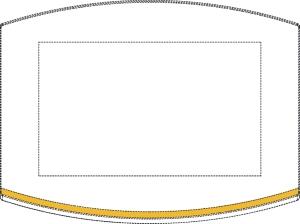 A final example of a position mark found to be decorative concerns the application depicted in Figure 3 for a yellow curve at the bottom edge of an electronic display unit. In the application, the sign was described as follows: “The positional mark is composed of a yellow curve, open at the upper edge, placed at the lower edge of an electronic display unit and extending the entire width of the unit. The dotted outline of the edges is purely to show that the curve is affixed to an electronic screen and does not form part of the mark itself.”
A final example of a position mark found to be decorative concerns the application depicted in Figure 3 for a yellow curve at the bottom edge of an electronic display unit. In the application, the sign was described as follows: “The positional mark is composed of a yellow curve, open at the upper edge, placed at the lower edge of an electronic display unit and extending the entire width of the unit. The dotted outline of the edges is purely to show that the curve is affixed to an electronic screen and does not form part of the mark itself.”
According to the General Court’s judgment in Sartorius Lab Instruments Gmbh v OHIM (General Court, Case T-331/12, February 26 2014 [IEF 13586]), this mark had no characteristic element or any memorable or eye-catching features likely to lend it a minimum degree of distinctiveness and enable the consumer to perceive it as anything other than a decoration typical of the goods in question.
Simple signs
Although one should obviously avoid filing extremely simple signs, OHIM Board of Appeal case law includes many examples of applications for position marks that were rejected for this reason. This generally includes signs which are found to contain nothing which may be considered eye-catching or memorable, or which have no characteristic features which can distinguish them from other identical or similar shapes, and thus are incapable of attracting the attention of the consumer. An example is the sign depicted in Figure 4, a figurative mark with a description of the mark which reads:
“The mark extends in longitudinal direction along the lines of the power tool.”
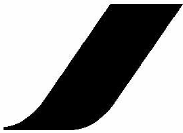
 On several occasions it has been held that a sign made up of a basic geometric figure (eg, a circle, line, rectangle, pentagon or parallelogram) is incapable, in itself, of sending a message which consumers can remember, which means that they will not consider it to be a trademark, unless it has acquired distinctive character through use (Pentagon, General Court, Case T-304/05 [IEF 4897] and Parallélogramme, General Court, Case T-159/10, April 13 2011). Indeed, these types of figure are normally perceived as ornamental features, rather than as distinctive signs.
On several occasions it has been held that a sign made up of a basic geometric figure (eg, a circle, line, rectangle, pentagon or parallelogram) is incapable, in itself, of sending a message which consumers can remember, which means that they will not consider it to be a trademark, unless it has acquired distinctive character through use (Pentagon, General Court, Case T-304/05 [IEF 4897] and Parallélogramme, General Court, Case T-159/10, April 13 2011). Indeed, these types of figure are normally perceived as ornamental features, rather than as distinctive signs.
Figure 2: In Margarete Steiff GmbH v OHIM, the court continued that the fixing of the button to the ear of the Steiff teddy bear “created a banal combination, which will be seen by the public as a decorative element, even functional”
Assessing validity – absolute grounds for refusal of shape marks
While the classification as figurative or 3D is not relevant for the assessment of distinctive character, it may be relevant for the applicability of absolute grounds for refusal Figure 3: In Sartorius Lab Instruments Gmbh v OHIM the court found that the mark had no characteristic element or any memorable or eye-catching features likely to lend it a minimum degree of distinctiveness under Article 7(1)(e) of the Community Trademark Regulation. This article excludes protection in an absolute manner for signs if they consist exclusively of shapes which result from the nature of the goods, are necessary to obtain a technical result or give substantial value to the goods.
Article 7(1)(e) does not define the types of sign which must be considered as shapes within the meaning of that provision. It makes no distinction between 3D shapes, 2D shapes and 2D representations of 3D shapes. Hence, it is often held that the exclusions may also apply to trademarks reproducing shapes, regardless of the dimension in which they are represented. The applicability of this article is thus not confined to 3D shapes and may also include position marks.
Since most position marks are refused for not being sufficiently distinctive, there is little European case law in which a position mark has been tested under the grounds of exclusion for 3D marks. However, in its decision of April 1 2015 (Christian Louboutin v Van Haren Schoenen), the District Court of The Hague considered it necessary to refer a question to the ECJ about the applicability of Article 3(1)(e) of the EU Trademark Directive (2008/95/EC), the equivalent of Article 7(1)(e) of the Community Trademark Regulation. Before doing so, the district court first asked the parties involved to comment on their intention to approach the ECJ and on the question to be asked. The position mark at stake concerns Louboutin’s heavily litigated trademark for a red sole.According to the court, this trademark has aspects of both a colour mark and a 3D mark, since it consists of the colour properties of the sole of a shoe. Further, it considered that Louboutin had sufficiently proven that the mark had acquired distinctiveness through use, since a significant part of the relevant public in the Benelux (ie, consumers of high-heeled women’s shoes) could, at the time the infringement commenced in Autumn 2012, identify Louboutin’s shoes as originating from Louboutin and could thus distinguish those shoes from similar products of other undertakings.
However, the district court also ruled that, based on Louboutin’s own statements in previous proceedings in the United States and on a research report submitted by the defendant, the red sole gives substantial value to the goods in question. Subsequently, according to the district court, the question thus arises as to whether the word ‘shape’ in the sense of Article 3(1)(e) (iii) of the directive is limited to 3D characteristics of (parts of) the goods, such as contours, dimensions and volume; or whether this also includes other (non-3D) characteristics of the goods, such as colour.
Interestingly, the district court considered that if colour is not covered by this absolute ground for refusal, the trademark right would enable the proprietor to prevent competitors indefinitely from using characteristics on their products which are sought and valued by the public, such as the red sole of a pump. According to the district court, this seems contrary to the rationale behind this ground for refusal. Likewise, the court considered that a trademark right could prevent a competitor from marketing reflective safety clothing or soft drinks in reflective, and thus insulating, packaging where this constituted a technical solution. We will have to wait and see whether this interesting question makes it to the ECJ.
Conclusion and future position
After reviewing many of the decisions rendered by the ECJ, the General Court and OHIM over the last 10 years, it is fair to conclude that position marks rarely meet the threshold of sufficient inherent distinctiveness. Although position marks are regularly accepted by OHIM, once they reach the General Court or the ECJ they tend to be refused. Most position marks do not meet the requirement that the sign depart significantly from the norm or customs of the sector. Lack of distinctiveness can be overcome by showing acquired distinctive character through use. However, the very high standard set by the ECJ to prove distinctiveness through use makes this quite difficult. Although position marks can be protected in theory, it is very difficult to obtain such protection in practice and to enforce position marks against a determined competitor effectively.
On top of that, the Presidency Compromise Proposals on the Community Trademark Regulation and the Trademark Directive published in May 2014 propose extending the absolute grounds for refusal of shape marks as included in Articles 7(1)(e) (i) to (iii) of the regulation and Articles 3(1)(e) (i) to (iii) of the directive, by adding the wording ‘or other characteristics’, as follows:
1. The following shall not be registered:
(e) signs which consist exclusively of:
(i) the shape or other characteristics which result from the nature of the goods themselves;
(ii) the shape or other characteristics of goods which are necessary to obtain a technical result;
(iii) the shape or other characteristics of goods which gives substantial value to the goods.
Clearly, it is not to be expected that life will become easier for applicants of position marks (and shape marks) if these legislative proposals are enacted. But even if they are not, based on the ECJ’s decision in Hauck GmbH v Stokke A/S (Case C-205/13, September 18 2014 (children’s chair) [IEF 14209]), applicants will most likely continue to face significant hurdles in registering position marks (even when such shapes have acquired distinctive character through use).
In the end, the lesson to be learned from the various negative decisions on position marks is that the European authorities have generally been reticent about affording perpetual protection to signs which, in many cases, are designs rather than trademarks. The good news is that – albeit for a limited period – in these cases it will often be possible to obtain design right protection, provided that this is applied for before public disclosure (or at least within the grace period).
Figure 4: The description of this figurative mark read: “The mark extends in longitudinal direction along the lines of the power tool”
Hidde J Koenraad is a partner at Simmons & Simmons LLP hidde.koenraad@simmons-simmons.com
 Bijdrage ingezonden door Antoon Quaedvlieg, Klos Morel Vos & Reeskamp. Lang hebben vormmerken voor hun bestaansrecht een uitputtingsslag moeten leveren tegen onwil van het Luxemburgse Hof, dat merkbescherming voor deze categorie kennelijk niet erg zag zitten. Maar nu is er een uitspraak die goede uitgangspunten kan scheppen voor althans één icoontje onder de 3D-merken, het KitKat ‘viervingermerk’.
Bijdrage ingezonden door Antoon Quaedvlieg, Klos Morel Vos & Reeskamp. Lang hebben vormmerken voor hun bestaansrecht een uitputtingsslag moeten leveren tegen onwil van het Luxemburgse Hof, dat merkbescherming voor deze categorie kennelijk niet erg zag zitten. Maar nu is er een uitspraak die goede uitgangspunten kan scheppen voor althans één icoontje onder de 3D-merken, het KitKat ‘viervingermerk’. Bijdrage ingezonden door Cees Mulder,
Bijdrage ingezonden door Cees Mulder,  Bijdrage ingezonden door Prof. Dr. Bernt Hugenholtz,
Bijdrage ingezonden door Prof. Dr. Bernt Hugenholtz,  Bijdrage ingezonden door Erwin Angad-Gaur, secretraris/directeur Ntb en
Bijdrage ingezonden door Erwin Angad-Gaur, secretraris/directeur Ntb en  Bijdrage ingezonden door Hidde Koenraad,
Bijdrage ingezonden door Hidde Koenraad,  When looking at the case law from the ECJ and the General Court, position marks are generally found to be similar to the categories of both figurative and 3D marks, since they concern figurative or 3D elements that are applied to the surface of a product. However, it is argued that the classification of a positional mark as a figurative or 3D mark is irrelevant for the purpose of assessing its distinctive character (see, among others, X Technology v OHIM, General Court Case T‑547/08, June 15 2010 (orange on toe of sock [
When looking at the case law from the ECJ and the General Court, position marks are generally found to be similar to the categories of both figurative and 3D marks, since they concern figurative or 3D elements that are applied to the surface of a product. However, it is argued that the classification of a positional mark as a figurative or 3D mark is irrelevant for the purpose of assessing its distinctive character (see, among others, X Technology v OHIM, General Court Case T‑547/08, June 15 2010 (orange on toe of sock [ A good example of this important distinction is Think Schuhwerk GmbH v OHIM (ECJ, Case C-521/13 P, September 11 2014) which concerned red aglets on shoelaces. The General Court had found that the aglets were indissociable from the shoes and, as such, the mark was indistinguishable from the appearance of the product. Being indistinguishable, unless acquired distinctiveness could be established, it would be very difficult for the aglets to have any distinctiveness at all. The ECJ would not accept a plea that the assessment of indissociability was wrong, as this was a matter of fact not law. Think Schuhwerk could not make out its appeal and the mark was rejected.
A good example of this important distinction is Think Schuhwerk GmbH v OHIM (ECJ, Case C-521/13 P, September 11 2014) which concerned red aglets on shoelaces. The General Court had found that the aglets were indissociable from the shoes and, as such, the mark was indistinguishable from the appearance of the product. Being indistinguishable, unless acquired distinctiveness could be established, it would be very difficult for the aglets to have any distinctiveness at all. The ECJ would not accept a plea that the assessment of indissociability was wrong, as this was a matter of fact not law. Think Schuhwerk could not make out its appeal and the mark was rejected. Another example of a sign found to be decorative is Landini Srl v OHIM (General Court, Case T-131/13, March 14 2014 [
Another example of a sign found to be decorative is Landini Srl v OHIM (General Court, Case T-131/13, March 14 2014 [ In its decision of January 16 2014 the General Court considered the famous ‘button in the ear’ motif of Steiff teddy bears (Margarete Steiff GmbH v OHIM, General Court, Case T-434/12, January 16 2014 [
In its decision of January 16 2014 the General Court considered the famous ‘button in the ear’ motif of Steiff teddy bears (Margarete Steiff GmbH v OHIM, General Court, Case T-434/12, January 16 2014 [ The concept of functionality – and the likelihood that a functional feature will not be inherently distinctive – was also discussed in Lange Uhren GmbH v OHIM (General Court, Case T-152/07, September 14 2009 [
The concept of functionality – and the likelihood that a functional feature will not be inherently distinctive – was also discussed in Lange Uhren GmbH v OHIM (General Court, Case T-152/07, September 14 2009 [ It is suggested that the General Court’s decision in this case would now be erroneous in light of Colloseum Holdings v Levi Strauss (ECJ, Case C-12/12, April 18 2013 [
It is suggested that the General Court’s decision in this case would now be erroneous in light of Colloseum Holdings v Levi Strauss (ECJ, Case C-12/12, April 18 2013 [ A final example of a position mark found to be decorative concerns the application depicted in Figure 3 for a yellow curve at the bottom edge of an electronic display unit. In the application, the sign was described as follows: “The positional mark is composed of a yellow curve, open at the upper edge, placed at the lower edge of an electronic display unit and extending the entire width of the unit. The dotted outline of the edges is purely to show that the curve is affixed to an electronic screen and does not form part of the mark itself.”
A final example of a position mark found to be decorative concerns the application depicted in Figure 3 for a yellow curve at the bottom edge of an electronic display unit. In the application, the sign was described as follows: “The positional mark is composed of a yellow curve, open at the upper edge, placed at the lower edge of an electronic display unit and extending the entire width of the unit. The dotted outline of the edges is purely to show that the curve is affixed to an electronic screen and does not form part of the mark itself.”
 Tijdens het drukbezochte symposium [
Tijdens het drukbezochte symposium [ Bijdrage ingezonden door Bas Kist,
Bijdrage ingezonden door Bas Kist,  Alle vraagstukken die het waarderen van bedrijven en ondernemingen zo lastig kunnen maken doen zich extra hardnekkig voor bij het waarderen van intellectuele eigendomsrechten. De verleiding van pseudo-benaderingen is dan ook sterk. Toch zou juist bij die waarderingen het gehele instrumentarium van de valuator benut moeten worden, om zo tot een degelijke en doordachte waarde te komen.
Alle vraagstukken die het waarderen van bedrijven en ondernemingen zo lastig kunnen maken doen zich extra hardnekkig voor bij het waarderen van intellectuele eigendomsrechten. De verleiding van pseudo-benaderingen is dan ook sterk. Toch zou juist bij die waarderingen het gehele instrumentarium van de valuator benut moeten worden, om zo tot een degelijke en doordachte waarde te komen. Bijdrage ingezonden door Paul Geerts,
Bijdrage ingezonden door Paul Geerts, 
























































































